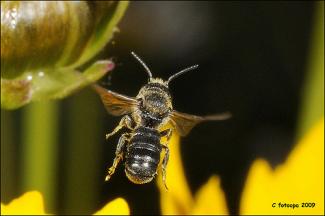
Image Credit: Frans
Pre-existing Cavity-Nesting Bees (Megachilidae: Ashmeadiella, Atoposmia, Heriades, Chelostoma, Protosmia, Proteriades)
All of these genera of solitary bees are close relatives of the mason-bees, but they are non-metallic. All of them generally require some sort of pre-existing insect burrow in wood, hollow plant pith, or soil-nesting bee burrow in which to nest. Most entomological knowledge about them comes from “trap-nesting”, when artificial straws are placed in natural habitats to be colonized by the bees. The cells are separated by chewed up plant material, often mixed with resin, like their relatives, Osmia.
All of the females collect and transport pollen to the nest by means of bristly combs on their belly. This group of bees contains both generalist-feeders and specialists. Nearly all the species are quite small and difficult to distinguish without a powerful hand-lens.


All of these genera look superficially very similar. Here we have Ashmeadiella on the left and Heriades on the right. All of the species in these genera are generally small to tiny bees. Most of them are black with white fasciae, but a significant percentage has red markings on the base of the abdomen (see below).


On the left is a reddened Ashmeadiella with a “normal tongue”. On the right is the face on a Proteriades, which would equally reddened, with a tongue covered with hooked bristles for harvesting and extracting pollen from the tiny tubular flowers of Cryptantha; all the species in this diverse genus (or subgenus) are specialists on this genus. There are several instances in the history of PNW bee evolution of other bee genera developing hooked tongue hairs that allow the exploitation of other plant genera.